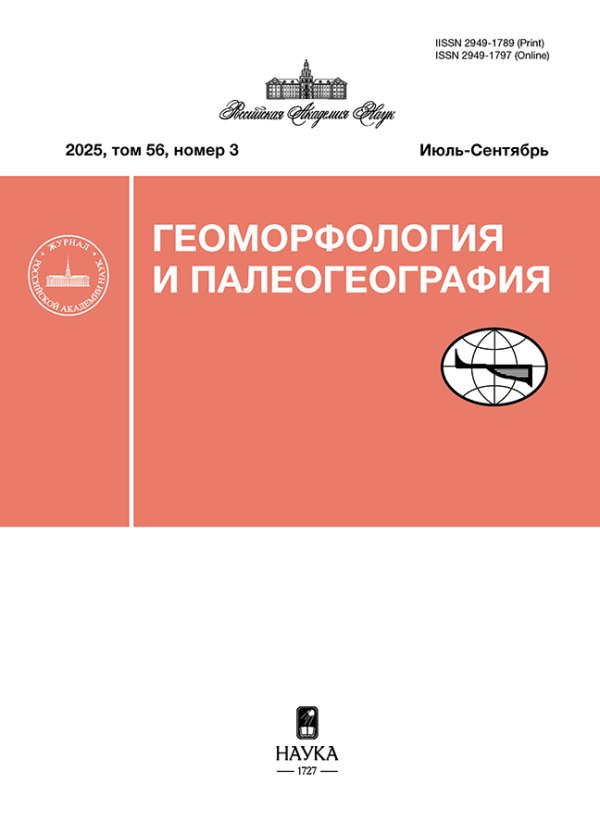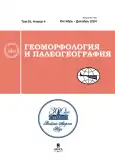Geomorphological formations of the South of Western Siberia and adjacent territories
- Authors: Novikov I.S.1
-
Affiliations:
- Sobolev Institute of Geology and Mineralogy of SB RAS
- Issue: Vol 55, No 4 (2024)
- Pages: 26-41
- Section: CATAFLUVIAL EVENTS IN THE QUATERNARY HISTORY OF NORTHERN EURASIA
- URL: https://modernonco.orscience.ru/2949-1789/article/view/682330
- DOI: https://doi.org/10.31857/S2949178924040037
- EDN: https://elibrary.ru/FHAEHX
- ID: 682330
Cite item
Abstract
Within the south of Western Siberia and adjacent territories, 23 types of Land systems (parageneses of genetically homogeneous surfaces/land units) have been identified, belonging to three physiographic zones: flat, foothill and mountain, as well as one type of extrazonal formations. The use of formational analysis has made it possible to identify genetic relationships between large spatially separated geomorphological elements, considering them as formational series. For the first time, a catafluvial geomorphological formation has been identified for the south of Western Siberia, and its place among other geomorphological formations in the region has been shown. A connection has been established between the ancient drainage troughs of Western Siberia, transit erosion valleys and catafluvial events (superfloods).
Full Text
##article.viewOnOriginalSite##About the authors
I. S. Novikov
Sobolev Institute of Geology and Mineralogy of SB RAS
Author for correspondence.
Email: novikov@igm.nsc.ru
Russian Federation, Novosibirsk
References
- Arkhipov S.A., Vdovin V.V., Mizerov B.V. et al. (1970). Zapadno-Sibirskaya ravnina (West Siberian Plain). M.: Nauka (Publ.). 279 p. (in Russ.)
- Arkhipov S.A., Volkov I.A., Volkova V.S. (1965). The main problems of paleogeography of the Quaternary period in the south of Western Siberia. In: Osnovnye problemy izucheniya chetvertichnogo perioda. M.: Nauka (Publ.). P. 218–228. (in Russ.)
- Astahov V.I. (2006). Evidence of Late Pleistocene ice-dammed lakes in West Siberia. Boreas. V. 35. P. 607–621. https://doi.org/10.1111/j.1502-3885.2006.tb01167.x
- Butvilovsky V.V. (1993). Paleogeografiya poslednego oledeneniya i golotsena Altaya: sobytiino-katastroficheskaya model’ (Paleogeography of the last glaciation and Holocene of Altai: an event-catastrophic model). Tomsk: Tomsk Universitet (Publ.). 252 p. (in Russ.)
- Devyatkin E.V. (1981). Kainozoi vnutrenney Azii (Cenozoic Inner Asia). M.: Nauka (Publ.). 196 p. (in Russ.)
- Dobretsov N.L. (Eds.). (1981). Metamorficheskie formatsii i metamorfogennye mestorozhdeniya (Metamorphic formations and metamorphogenic deposits). Novosibirsk: IGiG SO AN USSR (Publ.). 90 p. (in Russ.)
- Florensov N.A. (1964). On some general concepts in geomorphology. Geologiya i geofizika. № 10. P. 78–89. (in Russ.)
- Florensov N.A. (1971). On geomorphological formations. Geomorfologiya. № 2 P. 3–10. (in Russ.)
- Gadzhiev I.M. (Ed.). (1988). Geograficheskie i inzhenerno-geologicheskie usloviya Stepnogo (Geographical and engineering-geological conditions of Steppe Altai). Novosibirsk: Nauka. Sibirskoe otdelenie (Publ.). 97 p. (in Russ.)
- Ganeshin G.S. (Ed.). (1967). Geomorfologicheskaya karta SSSR. Masshtab 1:7500000 (Geomorphological map of the USSR. Scale 1:7500000). M.: Vsesoyuznyi aerogeologicheskii trest Ministerstva geologii SSSR (Publ.). 4 p. (in Russ.)
- Groswald M.G. (1965). Razvitie rel’efa Sayano-Tuvinskogo nagor’ya (Development of the relief of the Sayano-Tuva highlands). M.: Nauka (Publ.). 167 p. (in Russ.)
- Haq B.U., Al-Qahtani A.M. (2005). Phanerozoic cycles of sea-level change on the Arabian Platform. GeoArabia. № 10. Р. 127–160. https://doi.org/10.2113/geoarabia1002127
- Ivanov K.E., Novikov S.M. (Eds.). (1976). Bolota Zapadnoi Sibiri, ikh stroenie i gidrologicheskii rezhim (Swamps of Western Siberia, their structure and hydrological regime). L.: Gidrometeoizdat (Publ.). 448 p. (in Russ.)
- Kuznetsov Yu.A. (1964). Glavnye tipy magmaticheskikh formatsii (Main types of magmatic formations). M.: Nedra (Publ.). 387 p. (in Russ.)
- Mamedov G.M., Novikov I.S. (2015). Geomorphology of the Dzhungar Plain and its mountain frame. Geomorfologiya. № 1. P. 88–100. (in Russ.) https://doi.org/10.15356/0435-4281-2015-1-88-100
- Nikolaev V.A. (Ed.). (1978). Geomorfologicheskie formatsii Sibiri (Geomorphological formations of Siberia). Novosibirsk: IGiG SO AN USSR (Publ.). 162 p. (in Russ.)
- Novikov I.S. (2001). Сenozoic Strike-slip Tectonics in Altai. Geologiya i geofizika. Iss. 42. № 9. Р. 1311–1321. (in Russ.)
- Novikov I.S. (2003). Morphotectonics of Altai. Geomorfologiya. № 3. P. 10–25. (in Russ.) https://doi.org/10.15356/0435-4281-2003-3-10-25
- Novikov I.S. (2021). Changes in the global basis of denudation in the Late Mesozoic and Cenozoic and its influence on the formation of geomorphological structure in areas with different neotectonic regimes Geologiya i mineral’no-syr’evye resursy Sibiri. № 10s. P. 68–84. (in Russ.) https://doi.org/10.20403/2078-0575-2021-10c-69-85
- Novikov I.S., Mamedov G.M. (2018). Maps of transport permeability on a geomorphological basis (methodology and implementation using the example of the territory of northern Xinjiang). Vestnik Akademii voennykh nauk. № 2(63). P. 146–160. (in Russ.)
- Novikov I.S., Nazarov D.V., Mikharevich M.V. et al. (2023). The Azas Ice Sheet and Its Role in the Formation of Late Pleistocene Ice-Dammed Lakes in Southern Siberia: Case Study of Upper Kharal Paleolake. Geologiya i geofizika. Iss. 64. № 5. P. 595–606. (in Russ.) https://doi.org/10.15372/GiG2022146
- Shatsky N.S. (1965). Fatsii i formatsii (Facies and formations). M.: Nauka (Publ.). 232 p. (in Russ.)
- Sugorakova A.M., Yarmolyuk V.V., Lebedev V.I. (2023). Kainozoiskii vulkanizm Tuvy (Cenozoic volcanism of Tuva). Kyzyl: TuviKOPR (Publ.). 90 p. (in Russ.)
- Svarichevskaya Z.A. (1961). Drevnii peneplen Kazakhstana (Ancient peneplain of Kazakhstan). Leningrad: LGU (Publ.). 295 p.
- Zolnikov I.D. (2021). On the stratigraphic significance of the low terraces of the Suzun strata of the Upper Ob region under the regime. Geologiya i mineral’no-syr’evye resursy Sibiri. № 10s P. 7–17. (in Russ.) https://doi.org/10.20403/2078-0575-2021-10c-7-17
Supplementary files















